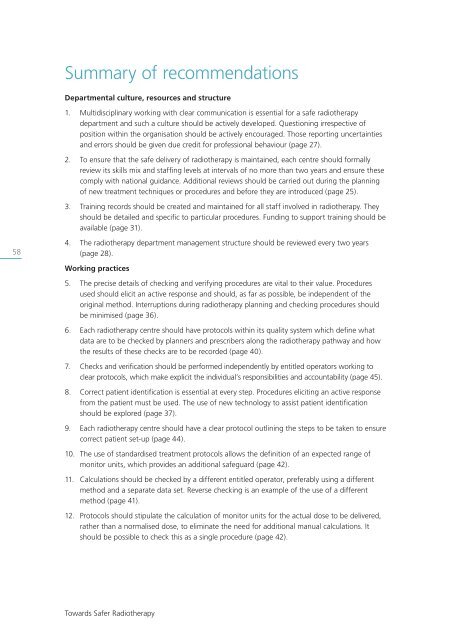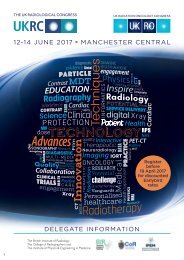Towards Safer Radiotherapy
Towards Safer Radiotherapy
Towards Safer Radiotherapy
Create successful ePaper yourself
Turn your PDF publications into a flip-book with our unique Google optimized e-Paper software.
Summary of recommendations<br />
Departmental culture, resources and structure<br />
1. Multidisciplinary working with clear communication is essential for a safe radiotherapy<br />
department and such a culture should be actively developed. Questioning irrespective of<br />
position within the organisation should be actively encouraged. Those reporting uncertainties<br />
and errors should be given due credit for professional behaviour (page 27).<br />
2. To ensure that the safe delivery of radiotherapy is maintained, each centre should formally<br />
review its skills mix and staffing levels at intervals of no more than two years and ensure these<br />
comply with national guidance. Additional reviews should be carried out during the planning<br />
of new treatment techniques or procedures and before they are introduced (page 25).<br />
3. Training records should be created and maintained for all staff involved in radiotherapy. They<br />
should be detailed and specific to particular procedures. Funding to support training should be<br />
available (page 31).<br />
58<br />
4. The radiotherapy department management structure should be reviewed every two years<br />
(page 28).<br />
Working practices<br />
5. The precise details of checking and verifying procedures are vital to their value. Procedures<br />
used should elicit an active response and should, as far as possible, be independent of the<br />
original method. Interruptions during radiotherapy planning and checking procedures should<br />
be minimised (page 36).<br />
6. Each radiotherapy centre should have protocols within its quality system which define what<br />
data are to be checked by planners and prescribers along the radiotherapy pathway and how<br />
the results of these checks are to be recorded (page 40).<br />
7. Checks and verification should be performed independently by entitled operators working to<br />
clear protocols, which make explicit the individual’s responsibilities and accountability (page 45).<br />
8. Correct patient identification is essential at every step. Procedures eliciting an active response<br />
from the patient must be used. The use of new technology to assist patient identification<br />
should be explored (page 37).<br />
9. Each radiotherapy centre should have a clear protocol outlining the steps to be taken to ensure<br />
correct patient set-up (page 44).<br />
10. The use of standardised treatment protocols allows the definition of an expected range of<br />
monitor units, which provides an additional safeguard (page 42).<br />
11. Calculations should be checked by a different entitled operator, preferably using a different<br />
method and a separate data set. Reverse checking is an example of the use of a different<br />
method (page 41).<br />
12. Protocols should stipulate the calculation of monitor units for the actual dose to be delivered,<br />
rather than a normalised dose, to eliminate the need for additional manual calculations. It<br />
should be possible to check this as a single procedure (page 42).<br />
<strong>Towards</strong> <strong>Safer</strong> <strong>Radiotherapy</strong>



